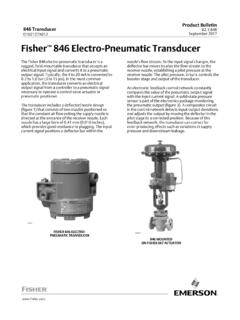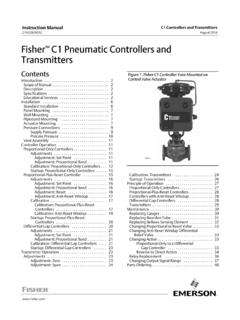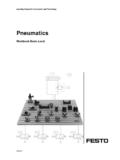Transcription of Unit 15: Electro, Pneumatic and Hydraulic Systems and Devices
1 Edexcel BTEC Level 3 Nationals specification in Engineering Issue 1 January 2010 Edexcel Limited 20091 Unit 15: Electro, Pneumatic and Hydraulic Systems and DevicesUnit code: K/600/0264 QCF Level 3: BTEC NationalCredit value: 10 Guided learning hours: 60 Aim and purposeThis unit will give learners the knowledge and skills needed to safely inspect, test and maintain pressurised fluid Systems that use electrical control Devices to make them introductionAn understanding of how fluid power Systems are used to control the operation of machinery and equipment is important for anyone thinking of taking up a career in engineering. Pneumatic (pressurised air or gas) Systems are widely used in manufacturing engineering to operate equipment such as packaging machines, automated assembly machines, clamping and lifting Devices .
2 There are many other everyday applications where air operated equipment is found, for example for opening doors on buses. Hydraulic (pressurised liquid) Systems are used where greater amounts of power are involved, a good example of this being the linear actuators that move the arms on excavators and other types of earth-moving equipment. This unit will give learners a broad understanding of the design and safe operation of pressurised fluid Systems that use electrical control Devices to make them work. This will include being able to read and produce simple fluid power circuit diagrams, understanding the principles of maintenance, and the use of test routines to identify faults in these Systems . Learners will investigate the impact that current legislation has on the design and safe operation of fluid power circuits, so that when carrying out practical work they are able to work safely.
3 High pressure Systems and Devices , particularly air-based ones, have hidden dangers. Because Hydraulic oil is carcinogenic learners will be made aware of the regulations covering the handling and disposal/recycling of this is then followed by a look at a selection of the components used in fluid power Systems and how they can be represented using universally recognised circuit diagram symbols. The components studied will include those used to generate a supply of high pressure air or Hydraulic fluid, prime movers such as linear actuators (cylinders) and control Devices such as valves and sensors. Learners will be introduced to some of the calculations that need to be carried out before designing and setting up a system. These include some basic pressure and volume calculations involving gases, determination of the correct size of cylinder to produce a specified extending force, and calculation of fluid flow rates needed to keep a system operating effectively.
4 Learners will then investigate how components can be linked together to form Systems for a specific purpose. Edexcel BTEC Level 3 Nationals specification in Engineering Issue 1 January 2010 Edexcel Limited 20092 The final section of the unit looks at how fluid power Systems are maintained in service and what happens if they develop faults. The emphasis here is on applying safe working practices, using predetermined systematic schedules and keeping accurate records for future outcomesOn completion of this unit a learner should:1 Know about the legislation, regulations and safety precautions that apply when working with fluid power systems2 Know the construction and operation of fluid power Devices and how they are represented as symbols in circuit diagrams3 Be able to apply fluid power principles in the design of circuits4 Be able to carry out maintenance, inspection, testing and fault-finding on fluid power BTEC Level 3 Nationals specification in Engineering Issue 1 January 2010 Edexcel Limited 2009 Unit content1 Know about the legislation, regulations and safety precautions that apply when working with fluid power systemsLegislation and regulations.
5 Legislation eg Health and Safety at Work Act 1974, Employment Act 2002, Factories Act 1961, Fire Precautions Act 1971, Deposit of Poisonous Waste Act 1972, European Conformity (CE marking); regulations eg Employment Equality (Age) Regulations 2006, Management of Health and Safety at Work Regulations 1999, Provision and Use of Work Equipment Regulations 1998, Control of Substances Hazardous to Health (COSHH) Regulations 2002, Lifting Operations and Lifting Equipment Regulations 1998, Manual Handling Operations Regulations 1992, Personal Protective Equipment at Work Regulations 1992, Confined Spaces Regulations 1997, Electricity at Work Regulations 1989, Control of Noise at Work Regulations 2005, Reporting of Injuries, Diseases and Dangerous Occurrences Regulations 1995, Workplace (Health, Safety and Welfare) Regulations 1992, Health and Safety (First Aid)
6 Regulations 1981, Carriage of Dangerous Goods and Use of Transportable Pressure Equipment Regulations 2004, Simple Pressure Vessels (Safety) Regulations 1991 (SI 1994/3098), Supply of Machinery (Safety) (Amendment) Regulations 2005 (SI 2005/831)Safety precautions: risk assessment of fluid power Systems ; assembling and testing electro, Pneumatic and Hydraulic Systems and Devices eg isolation of services (such as electrical, air, oil), escape of fluids at high pressure which may cause contact injury, Hydraulic oil contact with the skin, sudden movement of linear actuators causing entrapment injuries; personal protective equipment (PPE) eg safety glasses, gloves, overalls, footwear2 Know the construction and operation of fluid power Devices and how they are represented as symbols in circuit diagramsFluid power Devices : fluid conditioning eg supply tank, filter, pump, cooler, compressor, dryer, receiver, accumulator; fluid supply eg pipework, fittings, seals, drainage points; electrical supply Systems eg mains, low voltage regulated power supply units, AC, DC; fluid control valves eg directional (manual and solenoid), pilot, 4 port, 5 port, pressure reducing, non-return, flow rate; actuators eg linear, rotary; motors eg electric, air, Hydraulic ; position sensors eg reed switch, pressure switch, inductive, micro-switch.
7 System control eg programmable logic controller (PLC), electro mechanicalSymbols: relevant and current standards eg BS3939, BS2917, ISO 1219, European Fluid Power Committee (CETOP); symbols for common components eg fluid conditioning, fluid supply, electrical supply, control valves, actuators, motors, sensors, controlCircuit diagrams: diagrams eg Pneumatic , Hydraulic , block diagrams, system layout, displacement step diagrams; reference material eg component and equipment data sheets, ISO 1219-2, software (such as FluidSIM or automation Studio)Edexcel BTEC Level 3 Nationals specification in Engineering Issue 1 January 2010 Edexcel Limited 200943 Be able to apply fluid power principles in the design of circuitsFluid power principles: properties and behaviour of air and Hydraulic fluids; gas laws eg Boyle s, Charles , Gay-Lussac s, general gas, dew point; fluid flow eg Bernoulli s principle, volumetric rate, receiver volume, actuator flow requirements; fluid pressure eg units of measurement, Pascal s law, inlet and outlet pressure, pressure drop, actuator efficiency, clamping force.
8 Formulae (P1V1T2 = P2V2T1, displaced volume = piston area x stroke, volumetric flow rate = displaced volume/time, absolute pressure = gauge + atmospheric pressure, force = pressure x area, actuator force = pressure x area x efficiency) Circuits: Pneumatic eg multi-cylinder sequential operation, single-cylinder reciprocation with dwell, position and clamp an object using a two-cylinder arrangement, rotary actuator with reversing action; Hydraulic eg multi-cylinder sequential operation, single-cylinder reciprocation with dwell and regeneration, Hydraulic motor with reversing action4 Be able to carry out maintenance, inspection, testing and fault-finding on fluid power systemsMaintenance: routines eg frequency of maintenance, manuals and reference documentation, keeping of accurate records using paper- or software-based Systems ; components (electro, Pneumatic , Hydraulic ); Systems eg electro- Pneumatic , electro-hydraulicInspection: functional eg at component level, as a system, performance against specification; keeping of accurate records.
9 Report eg component drawing, system circuit diagram, digital images, inspection checklist, record of visual observations made against checklist, conclusions, recommendations Testing: performance eg against specification, reliability; keeping of accurate records; report eg system circuit diagram, system specification, test schedule, list of test equipment, record test results, record visual observations, compare test results with system specification, recommendations for future actionsFault finding: identify faults in fluid power Systems eg manual diagnosis, visual examination, unit substitution, input to output, injection and sampling, half-split technique, six-point technique, self-diagnostic techniques using programmable electronic equipment, effect of malfunctions; fault-finding aids eg functional charts, diagrams, flow charts, troubleshooting charts, component data sheets, operation and maintenance manuals, specialised equipment; record faults eg paper based, software based, analyse data; report eg system circuit diagram, record test results, record visual observations, compare test results with system specification, record faults and cross reference to circuit diagram, identify type of fault, strategy for rectification of fault5 Edexcel BTEC Level 3 Nationals specification in Engineering Issue 1 January 2010 Edexcel Limited 2009 Assessment and grading criteriaIn order to pass this unit, the evidence that the learner presents for assessment needs to demonstrate that they can meet all the learning outcomes for the unit.
10 The assessment criteria for a pass grade describe the level of achievement required to pass this and grading criteriaTo achieve a pass grade the evidence must show that the learner is able to:To achieve a merit grade the evidence must show that, in addition to the pass criteria, the learner is able to:To achieve a distinction grade the evidence must show that, in addition to the pass and merit criteria, the learner is able to:P1 list the aspects of health and safety legislation and regulations that apply when working with fluid power equipment and systemsM1 explain and compare the construction and operation, including legislation and safety precautions, of a Pneumatic system with that of a Hydraulic system D1 evaluate the use of self-diagnostic techniques to monitor the performance of fluid power Systems used in industryP2 describe the safety precautions that apply when working with fluid power equipment and systemsM2 explain the procedures used when fault finding in electro- Pneumatic and electro- Hydraulic explain the importance of carrying out maintenance, inspection, testing and fault-finding on fluid power describe, with the aid of suitable diagrams.













